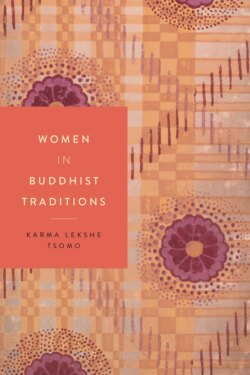Читать книгу Women in Buddhist Traditions - Karma Lekshe Tsomo - Страница 16
На сайте Литреса книга снята с продажи.
Women Disseminating the Dharma
ОглавлениеThe Buddha’s teachings traveled beyond India quite early, perhaps even during the Buddha’s lifetime, and women played pivotal roles in the transnational dispersion of Buddhism. According to the Mahāvaṃsa, the teachings were transmitted to the island of Lanka (now Sri Lanka), off the southeast coast of India, as early as the third century BCE. Just six months after Emperor Aśoka’s son Bhikkhu Mahinda traveled to Lanka to teach and ordain the first monks of the Sinhalese bhikkhu saṅgha, Aśoka’s daughter Bhikkhunī Saṅghamittā traveled there to teach and ordain the first nuns, initiating the Sinhalese bhikkhuṇī saṅgha.52 Legend has it that Mahinda reached the island 236 years after the Buddha passed away. There, he delighted King Paṇḍuvāsadeva and forty thousand followers with the Buddha’s teachings. When Princess Anulā, wife of the king’s brother, asked Mahinda’s permission to join the order, he explained that he was not permitted to perform the ordination of a bhikkhuṇī without the participation of the bhikkhuṇī saṅgha.53 Instead, he recommended that the king invite his sister Saṅghamittā to come from India for the ordination.54
Saṅghamittā sailed to Lanka in the company of a large retinue and brought with her a sapling of the bodhi tree, under which the Buddha achieved awakening, in a golden vase (see figure 1.3). Once she arrived and the tree took root, Princess Anulā received ordination along with a thousand other women.55 The account is full of wondrous miracles that inspire awe in the minds of the faithful. It follows a storyline similar to that of the Buddha: men are admitted to the order first, and women are allowed to join soon thereafter. Both as the bearer of the venerated bodhi tree and as the founder of the bhikkhuṇī saṅgha on the island of Lanka, Saṅghamittā was a key figure in the early transmission of the Buddha’s teachings. In contemporary Sri Lanka, her courage and contributions are commemorated every year on Saṅghamittā Day on the full moon of December, the only national holiday in the world named in honor of a woman.56
The next famous episode in women’s dissemination of the teachings began with the voyage of Bhikkhunī Devasārā (Tessara) from Lanka to China in the fifth century CE. The story is recounted in Lives of Eminent Nuns by Baochang (Pao-ch’ang), a Chinese scholar monk who lived between the fourth and sixth centuries CE and compiled the biographies of 485 eminent monks and 65 eminent nuns in China.57 The nuns described were known for their devotion, discipline, meditation practice, and abilities to elicit responses from the buddhas and bodhisattvas. Throughout Chinese history, Buddhist nuns have made significant contributions to Buddhism. Preserving the lineage (unbroken transmission) of full ordination for women, and transmitting it to Korea, Taiwan, and Vietnam, is one example. Another example is the exceptional achievements of Buddhist nuns in meditation practice. For instance, historical documents record the name of Zhiyuan Xinggang (1597–1654), a master in the practice of Linji Chan Buddhism, which was subsequently transmitted to Japan (Rinzai Zen) and other countries.58 Buddhist nuns continue to make significant contributions up to the present day through social activism, as can be seen in the work of Bhikṣuṇī Cheng Yen and Bhikṣuṇī Chao Hwei in Taiwan59 and others around the world.
Figure 1.3. Saṅghamittā, daughter of Emperor Aśoka, who traveled with a bodhi tree sapling to Sri Lanka, where she performed the first ordination of Buddhist nuns in the country. Belanvilla Maha Vihara, Colombo, Sri Lanka. Credit: Photo by Shravasti Dhammika.
